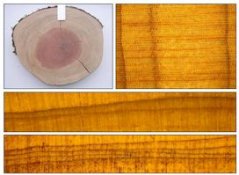Project
Growth and population dynamics of Juniperus procera from Ethiopia
Most semi-arid regions are facing an increasing scarcity of the woody vegetation mainly due to anthropogenic deforestation and aggravated by climate changes. This also holds true for juniper forests in the Ethiopian highlands.

Most semi-arid regions are facing an increasing scarcity of the woody vegetation mainly due to anthropogenic deforestation and aggravated by climate changes. This also holds true for juniper forests in the Ethiopian highlands. By using dendrochronology we studied tree age, population dynamics, growth behaviour, and climate-growth relationships of juniper (Juniperus procera) from two Ethiopian highland forests to gain information about driving environmental forces of growth changes as well as to develop proxies for climate reconstruction. Visible growth layers of the juniper wood were proved to be annual rings. Tree-ring sequences could be crossdated between trees growing at the same site and between 350 km distant sites. Evidence was presented that annual growth of junipers is mainly controlled by one climatic factor, namely precipitation. This strong precipitation influence proves the potential of African juniper chronologies for accurate climate reconstruction and points out the relevance of building a network of juniper chronologies across East Africa.
Cooperation
- Adane Abebe, Prof. Dr. ing. G. Förch, Siegen University, Germany, Water Management Department
- T.H.G. Wils, Dr. I. Robertson, University of Wales Swansea, UK, Tropical Dendrochronology
- Prof. Dr. A. Bräuning, Erlangen University, Germany, Institut for Geography
Publications
- Wils, T.; Sass-Klaassen, U.; Eshetu, Z.; Bräuning, A.; Gebrenirstos, A.; Couralet, C.; Robertson, I.; Touchan, R.; Koprowski, M.; Conway, D.; Briffa, K.R.; Beeckman, H. (2011) Dendrochronology in the dry tropics: the Ethiopian case. Trees -Structure and Function (3) 25:345-354
- Wils, T.; Robertson, I.; Eshetu, Z.; Touchan, R.; Sass-Klaassen, U.; Koprowski, M. (2011) Crossdating Juniperus procera from North Gondar, Ethiopia. Trees-Structure and Function (1) 25:71-82
- Wils, T.; Robertson, I.; Eshetu, Z.; Koprowski, M.; Sass-Klaassen, U.; Touchan, R.; Loader, N. (2010) Towards a reconstruction of Blue Nile baseflow from Ethiopian tree rings. Holocene. Holocene 20 (8). - p. 837 - 848.
- Wils, T.; Robertson, I.; Eshetu, Z.; Sass-Klaassen, U.; Koprowski, M. (2009) Periodicity of growth rings in Juniperus procera from Ethiopia inferred from crossdating and radiocarbon dating. Dendrochronologia 27 (1). - p. 45 - 58.
- Sass-Klaassen, U.; Couralet, C.; Sahle, Y.; Sterck, F.J. (2008) Juniper from Ethiopia contains a large-scale precipitation signal. International Journal of Plant Sciences 169 (8). - p. 1057 - 1065.
- Sass-Klaassen, U.; Couralet, C.; Sahle, Y.; Sterck, F.J. (2008) Juniper from Ethiopia contains a large-scale precipitation signal. International Journal of Plant Sciences 169 (8). - p. 1057 - 1065.
- Abebe, A.; Förch, G.; Sass-Klaassen, U. (2007). Reconstructing Hydrological Drought Using Proxy Data -the case of Wabi Shebele River Basin. FWU Water Resources Publications: Catchment and Lake Research,Volume No: 06 / 2007, ISSN No. 1613-1045, LARS 2007
- Couralet, C.; Sass-Klaassen, U.; Sahle, Y.; Sterck, F.J.; Bekele, T.; Bongers, F.J.J.M. (2007) Dendrochronological investigations on Juniperus procera from Ethiopian dry afromontane forests. In: TRACE - Tree Rings in Archaeology, Climatology and Ecology, Vol. 5 Proceedings of the DENDROSYMPOSIUM, 20-22 April, 2006, Tervuren, Belgium. - Jülich : Forschungszentrum Jülich GmbH, - p. 73 - 79.Dendrosymposium 2006. Tervuren, Belgium., 2006-04-20/ 2006-04-22 (PDF 473 KB)
- Couralet, C.; Sass-Klaassen, U; Sterck, F.J.; Zuidema, P. (2005 ) Combining dendrochronology and matrix modelling in demographic studies: An evaluation for Juniperus procera in Ethiopia. Forest Ecology and Management 216 (2005). - ISSN 0378-1127 - p. 317 - 330.
- Couralet, C.; Sass-Klaassen, U.; Sahle, Y.; Sterck, F.J.; Bekele, T.; Bongers, F.J.J.M. (2007) Application of dendrochronology to sustainable forest management in Ethiopia. Poster. (PDF 124 KB)
MSc theses
- Couralet, C. (2004). Growth and population dynamics of Juniperus procera in an Ethiopian highland forest: dendrochronology and matrix model. (supervision: Sass-Klaassen, Sterck, in cooperation with Bekele/F.R.C. Ethiopia)
- Sahle, Y. (2005). Population dynamics of Juniperus procera in high mountain forests of Ethiopia: Dendrochronology and Matrix modeling. (supervision: Bongers, Sass-Klaassen, Sterck, in cooperation with Bekele/EARO)